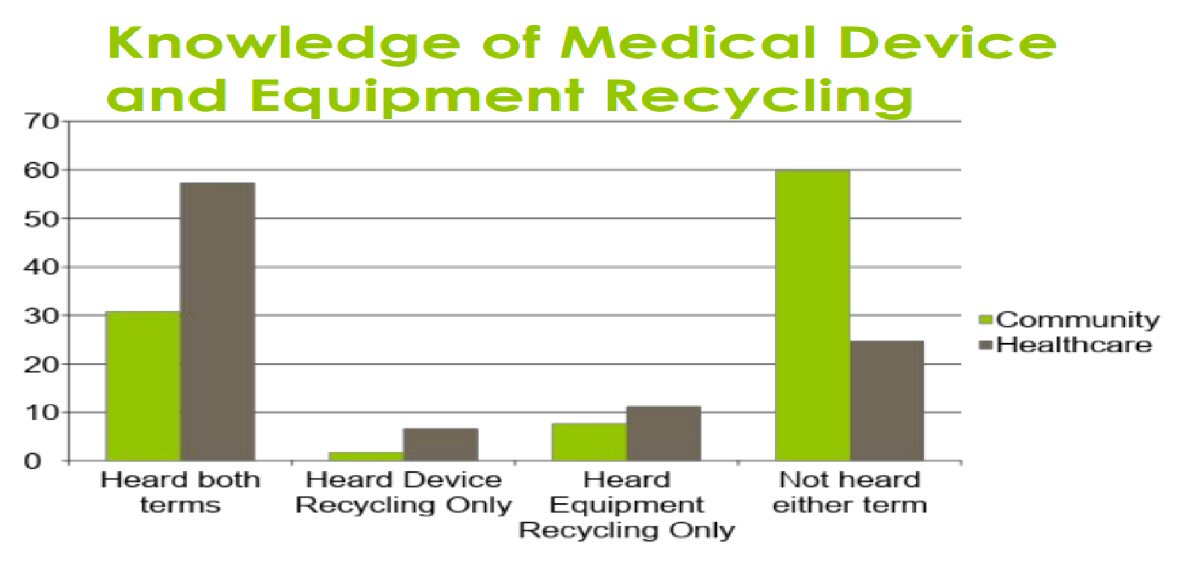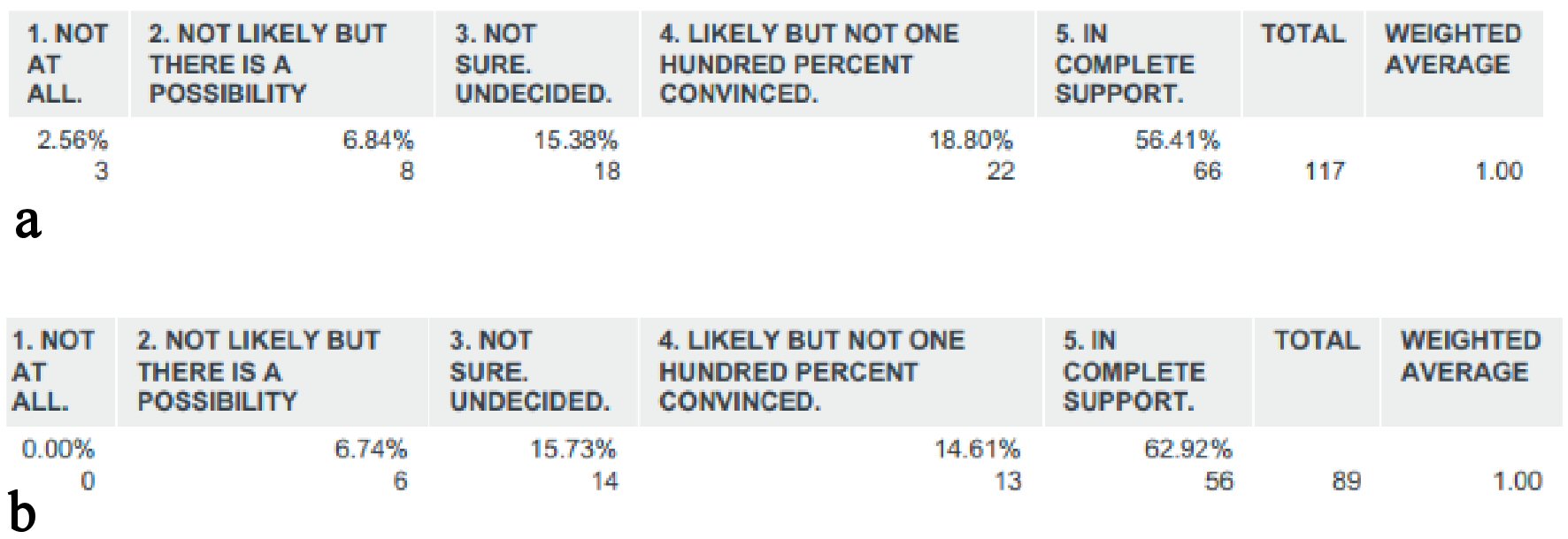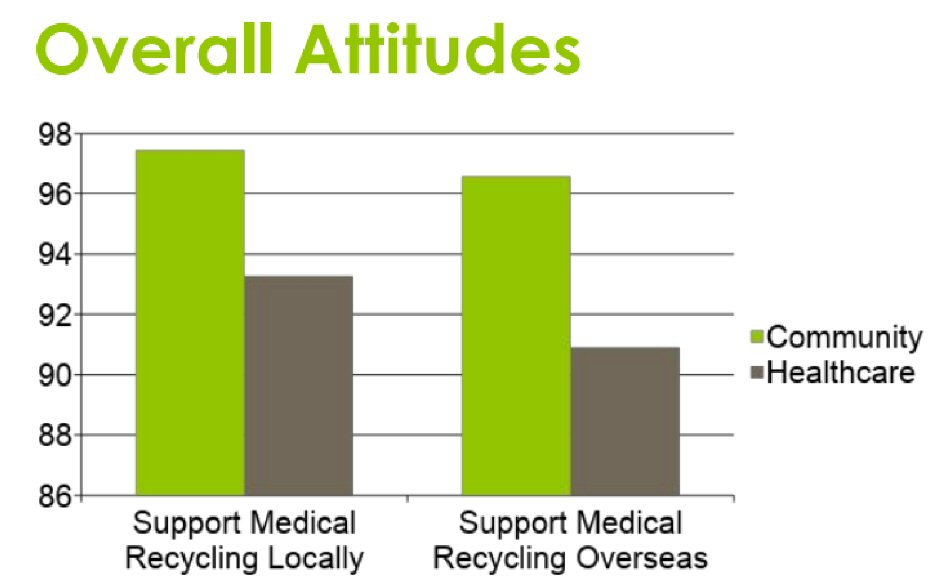| Cardiology Research, ISSN 1923-2829 print, 1923-2837 online, Open Access |
| Article copyright, the authors; Journal compilation copyright, Cardiol Res and Elmer Press Inc |
| Journal website http://www.cardiologyres.org |
Short Communication
Volume 9, Number 4, August 2018, pages 239-243
A Community Level Sample Survey to Determine CurrentUnderstanding About Medical Recycling of Cardiovascular ImplantableElectronic Devices
Milan Mahesha, Munish Sharmab, Daniel AN Mascarenhasc, d, e
aMoravian Academy, Bethlehem, PA, USA
bDepartment of Heart Failure and PulmonaryHypertension, Hackensack University Medical Center, Hackensack, NJ,USA
cDrexel University College of Medicine,Philadelphia, PA 19129, USA
dEaston Hospital, Easton, PA 18042, USA
eCorresponding Author: Daniel ANMascarenhas, Drexel University College of Medicine, Philadelphia,PA 19129, USA
Manuscript submitted July 10, 2018, accepted July 20, 2018
Short title: Understanding About Recycling ofCIEDs
doi: https://doi.org/10.14740/cr755w
| Abstract | ▴Top |
Background: Medical recycling and reutilization of cardiovascular implantableelectronic devices (CIEDs) have a significant impact not only in patientsof low-income countries but may also in certain patients in the UnitedStates who do not have sufficient medical insurance coverage. Themain determining factor for future utility and popularity of recycledmedical devices is thorough understanding about this topic amongstpublic and healthcare professional. To the best of our knowledge,there has been no study conducted so far at a community level to determinethe understanding in public and healthcare personnel about recyclingof medical devices including CIEDs. We sought to determine existingknowledge and attitude about recycling of CIEDs amongst representativesample population in a community.
Methods: A questionnaire was sent for online completion to multiple peoplein the community, healthcare and funeral home in Lehigh Valley, Pennsylvania,USA. The questionnaire was designed in order to assess three maincategories; knowledge, attitude and practice. We called this a KAPstudy which is an acronym for knowledge, attitude and practice survey.
Results: We got 117 responses to our questionnaire from community members(55.45%), 89 responses (42.18%) from the healthcare personnel andfive responses (2.37%) from funeral homes. About 30.77% communityparticipants had heard about medical devices recycling compared to57.30% participants from healthcare sector. A total of 88.64% of medicalprofessionals were aware that there are people in the world who diebecause they cannot afford CIEDs while 73.50% of community participantswere also found to be aware of this fact. Higher percentages of healthcareprofessionals were found to be willing to personally consider a decisionabout medical device donation compared to community participants.
Conclusions: CIED reutilization can improve quality of life among many patientswith low or medium socioeconomic status. People should be made moreaware about the benefits of CIED reutilization. Concerns about device-relatedinfections, complications and law suits should be addressed to helpimprove their utility.
Keywords: Medical device recycling; Cardiovascular electronic implantable devices; Sample survey; Quality of life
| Introduction | ▴Top |
With technological advancement in healthcare industry, there isan increasing need of systematic disposal of old medical devices.In cases of medical devices that can be sanitized and verified forsignificant functionality, the concept of reuse for the benefit oflow- and medium-income communities, who are neither able to affordmedical insurance nor able to buy such devices, can be of tremendoushelp. This concept of medical recycling has been found to be promisingin cases of cardiovascular implantable electronic devices (CIEDs)explanted from a deceased person as evident in multiple studies publishedpreviously [1-3]. Permanent pacemakers (PPM) andimplantable cardioverter defibrillators (ICD) are primarily referredto as CIEDs. Their recycling and reutilization can make a significantimpact in terms of health-related quality of life and longevity ofthe patients suffering from cardiovascular diseases [1, 4]. An ICD generator may cost between 20,000 US dollar (USD)and 40,000 USD while a PPM can cost 2,500 to 3,000 USD on an average[1]. The average costs of CIEDsexceed the per capita annual income of most of the people living inlow- and middle-income countries [5]. Thus, medical recycling and reutilization of CIEDs canhave a significant impact not only in patients of low-income countriesbut also in certain patients in the United States (USA) who do nothave sufficient medical insurance coverage. This can also decreasecost of healthcare in the USA that is spiraling out of control. Accordingto a study published in 2015, the total health care cost of patientsundergoing revision of CIED itself was approximately 185 million USDbetween 2004 and 2014 [6].The main determining factor for future utility and popularity of recycledmedical devices is thorough understanding about this topic amongstgeneral public and healthcare professional. To the best of our knowledge,there has been no study conducted so far at a community level to determinethe understanding in general public and healthcare personnel aboutrecycling of medical devices including CIEDs. In this study, we soughtto determine existing knowledge and attitude about recycling of CIEDsamongst representative sample population in a community. We also aimedto determine factors affecting current attitude towards this approachand main concerns about reutilization of CIEDs.
| Materials and Methods | ▴Top |
A questionnaire was sent for online completion to multiple peoplein the community, healthcare and funeral home in Lehigh Valley, Pennsylvania,USA. The questionnaire was designed in order to assess three maincategories; knowledge, attitude and practice. We called this a KAPstudy which is an acronym for knowledge, attitude and practice survey.This survey intended to assess baseline knowledge, measure attitudeand recognize any barriers to practice. Questionnaire had common setof questions as well as those modified to suit the nature of the respondergiven the fact that the participants were both healthcare professionalsand community members. Categorical data obtained in the study havebeen presented as frequencies and/or percentages. Where ever applicable,P-value was calculated by t-test and a P value of< 0.05 was considered statistically significant.
Questionnaire used for survey
Table 1 shows the questionnaireused for survey.
 Click to view | Table 1. Questionnaire Used for Survey |
| Results | ▴Top |
There were totally 211 respondents in the survey. All the participantsin the survey were more than 18 years in age. We got 117 responsesto our questionnaire from community members (55.45%), 89 responses(42.18%) from the healthcare personnel and five responses (2.37%)from funeral homes. Amongst the healthcare professionals, 59 (66.29%)were physicians, 11 (12.36%) were healthcare administrators while19 (21.35%) were non-physician healthcare provider. About 30.77% communityparticipants had heard about medical devices recycling compared to57.30% participants from healthcare sector (Fig. 1).
 Click for large image | Figure 1. Bar diagram showing comparative responses about pre-existing knowledgeabout medical device and/or medical devices recycling among respondersfrom community (including funeral homes) versus healthcare personnel. |
Only 1.71% of healthcare professionals were found to have CIEDsimplanted in them compared to 14.61% participants from community andfuneral homes. Totally 41.88% of community participants group hadfamily members or friends with CIEDs compared to 80.90% of healthprofessionals. There were 51.69% of medical professionals said theywere aware that CIEDs could potentially be removed after death anddonated to other people compared to 20.51% of non-medical professionals;and 88.64% of medical professionals were aware that there are peoplein the world who die because they cannot afford CIEDs while 73.50%of community participants were also found to be aware of this fact.Higher percentages of healthcare professionals were found to be willingto personally consider a decision about medical device donation comparedto community participants (Fig. 2a,b).
 Click for large image | Figure 2. (a) Response among community participants about how likely theyare to personally consider/influence a decision about medical devicedonation (on a scale of 1 - 5). (b) Response among healthcare professionals(lower table) about how likely they are to personally consider/influencea decision about medical device donation (on a scale of 1 - 5). |
There were 78.63% of community participants who thought that participationin medical device donation adds meaning to one’s life while67.42% of medical professionals agreed that device donation adds meaningto their organization’s core mission. About 13.48% of healthcareprofessionals believed that hospital or healthcare organizations thatthey were associated with would be willing to potentially implementa program of postmortem CIED donation and 20.22% only believed thattheir values would potentially disallow them to personally participatein CIED donations. Only 2.59% of non-medical participants in the surveybelieved that their religious or any other beliefs would disallowthem to participate in device donation. The most common concern aboutCIED donation amongst both the groups was “risk of infection”followed by “potential lawsuits due to device malfunctions.”All 89 participants amongst medical professional responded to thisquestion but only 115 participants amongst community/funeral homesresponded to this question. All the responses to this question aresummarized in Table 2.
 Click to view | Table 2. Concerns About CIED Donation |
Twenty-six healthcare professionals (29.55%) estimated that around60-80% of medical device and devices are trashed while one did notchoose to answer this question. Thirty-four non-medical professionalparticipants in the survey (29.31%) estimated that around 60-80% amedical device and devices are trashed. Most healthcare professional(53%) estimated that around 2-10% of devices are given to other peoplein need while most community/funeral homes participants (50.44%) estimatedthat 10-50% of these devices are given to people who were actuallyin need. A totally of 83 (93.26%) of healthcare professionals preferredthe medical devices to be donated to people in need within the communityand similar results were obtained amongst community participants as113 out of 117 total responders to this question (96.58%) opted forlocal donation (Fig. 3). Notably,90.91% of healthcare professional and 97.44 percentages of total community/funeralhomes participants were found to be in favor of a sound mechanismto deliver CIEDs to poor and needy people overseas and were willingto spread the word and/or participate in the same. It was also noticedthat people that their family/friends with implantable cardiac devicesare more likely to be positive in that support for medical recycling:93.88% compared to those people who did not have a family member orfriends with such devices (79.141%) (P < 0.05). About 9.09% ofhealthcare administrators were willing to implement the medical devicerecycling in their respective institutions despite their appreciationabout the idea per se.
 Click for large image | Figure 3. Both healthcare and community level participants in the surveyheavily preferred the donation of medical devices to local peopleover sending them to foreign countries. |
| Discussion | ▴Top |
Reutilization of CIEDs is a very feasible option and a great sourceof healthcare resource for underprivileged communities. Postmortemextraction of CIEDs is a prime source of explanted devices for reutilization[1]. In the United States,around 225,000 PPMs are implanted every year [5] and these devices have average longevity of 11.2± 2.6 years [7]. Ithas been estimated that around 85% of deceased with CIEDS are buriedwithout getting these devices removed [3]. According to a study in 2012, funeral homes in Michiganwere able to collect 3,176 devices, out of which 21% had good batterylife [8, 9]. Thus, there are feasible options to obtain CIEDsfor the purpose of recycling and utilization. In spite of this feasibility,awareness regarding the benefits of recycled CIEDs is low in our communityas evident in our sample study. Even amongst people who know aboutreutilization of CIEDs, there exist a disparity between belief andimplementation. As seen in our study as well, over 90% of participantswere found to be personally supporting medical recycling and around55% think that medical recycling is in line with their organization’score mission but only 9% out of these want to definitely support implementationin their hospitals. The main concerns among healthcare professionalsand community members regarding implementation of medical recyclingof CIEDs are infections and malfunctions related to the devices. Severalstudies have shown that reutilization of CIEDs do not actually increasethe risk of infection or mortality in comparison to newer surgicalimplantation of device. As per a meta-analysis regarding reuse ofPPMs performed on a pooled data of 2,270 subjects, there was no significantdifference in infection rate between recycled PPMs and new ones [9]. The concern for legal lawsuitdue to malpractice associated with CIEDs is higher among healthcareprofessional. To increase the popularity of medical recycling andnegate the fear of increased infection risk and malpractice suits,there is a need for standardized disinfection process for recycleddevices that is approved and accepted by a governing legal body. Therehas to be a formal process to re-certify these devices and devices.The United States Food and Drug Administration (US-FDA) considersCIEDs as single-use devices and thus views it as an objectionablepractice to reutilize them [10]. Since there are no federal laws to address the ownership of CIEDsafter a patient’s demise, there is no definite individual orcompany who can solely lay claim to explanted CIEDs [11]. Thus, an advanced directiveoutlining the patient wishes about reutilization of implanted cardiacdevices has been suggested by some authors to help guide funeral homesin the process of retrieving CIED for the purpose of donation. Effortshave to be made to convince people that there is nothing illegal aboutmedical recycling and subsequent reutilization of devices like CIEDs.Awareness regarding these issues can be made more rampant with helpof larger group of volunteers who can spread the masses effectively.Electronic media, websites dedicated to medical device recycling andeducation tools like brochures and pamphlets can be utilized to spreadthe message. The concern about supporting medical recycling overseascan be minimized by standard device procurement, re-implantation andfollow-up process.
Conclusions
Reutilization of medical devices like CIEDs is a noble cause whichhas widespread support of both community people and healthcare personnel.It is very feasible to obtain CIEDs from a deceased person and thiscan improve the quality of life of many patients. However, there remainsome concerns, mainly infection and legal concerns among healthcareadministrators which we should address before implementing this ona large scale.
Conflict of Interest
The authors declare no conflict of interest.
| References | ▴Top |
- Runge MW, Baman TS, Davis S, Weatherwax K, Goldman E, EagleKA, Crawford TC. Pacemaker recycling: A notion whose time has come.World J Cardiol. 2017;9(4):296-303.
doi pubmed - Gakenheimer L, Romero J, Baman TS, Montgomery D, Smith CA,Oral H, Eagle KA, et al. Cardiac implantable electronic device reutilization:battery life of explanted devices at a tertiary care center. PacingClin Electrophysiol. 2014;37(5):569-575.
doi pubmed - Badin A, Baman TS, Eagle KA, Crawford TC. Pacemaker reutilizationfor those in underserved nations: examining preliminary data and futureprospects. Interventional Cardiology. 2013;5:695-702.
doi - Lamas GA, Orav EJ, Stambler BS, Ellenbogen KA, Sgarbossa EB,Huang SK, Marinchak RA, et al. Quality of life and clinical outcomesin elderly patients treated with ventricular pacing as compared withdual-chamber pacing. Pacemaker Selection in the Elderly Investigators.N Engl J Med. 1998;338(16):1097-1104.
doi pubmed - Mond HG, Irwin M, Ector H, Proclemer A. The world survey ofcardiac pacing and cardioverter-defibrillators: calendar year 2005an International Cardiac Pacing and Electrophysiology Society (ICPES)project. Pacing Clin Electrophysiol. 2008;31(9):1202-1212.
doi pubmed - Patel JD, Schmier J, Lau E. Healthcare costs for Cardiac Implantableelectronic device (CIED) revision procedures from 2004-2012. Circulation:Cardiovascular Quality and Outcomes.2015;8:A326.
- Benkemoun H, Sacrez J, Lagrange P, Amiel A, Prakash A, HimmrichE, Aime E, et al. Optimizing pacemaker longevity with pacing modeand settings programming: results from a pacemaker multicenter registry.Pacing Clin Electrophysiol. 2012;35(4):403-408.
doi pubmed - Baman TS, Crawford T, Sovitch P, Meier P, Sovitch N, GakenheimerL, Kirkpatrick J, et al. Feasibility of postmortem device acquisitionfor potential reuse in underserved nations. Heart Rhythm. 2012;9(2):211-214.
doi pubmed - Baman TS, Meier P, Romero J, Gakenheimer L, Kirkpatrick JN,Sovitch P, Oral H, et al. Safety of pacemaker reuse: a meta-analysiswith implications for underserved nations. Circ Arrhythm Electrophysiol.2011;4(3):318-323.
doi pubmed - US FDA Compliance Manuals. CPG Sec 310.100 Pacemaker Reuse(CPG) 7124.12). [accessed 2015 Dec 12] Available from: http://www.fda.gov/ICECI/ComplianceManuals/CompliancePolicyGuidanceManual/ucm073891.htm.
- Kirkpatrick JN, Papini C, Baman TS, Kota K, Eagle KA, VerdinoRJ, Caplan AL. Reuse of pacemakers and defibrillators in developingcountries: logistical, legal, and ethical barriers and solutions.Heart Rhythm. 2010;7(11):1623-1627.
doi pubmed
This article is distributed under the terms of the Creative Commons Attribution Non-Commercial 4.0 International License, which permits unrestricted non-commercial use, distribution, and reproduction in any medium, provided the original work is properly cited.
Cardiology Research is published by Elmer Press Inc.











